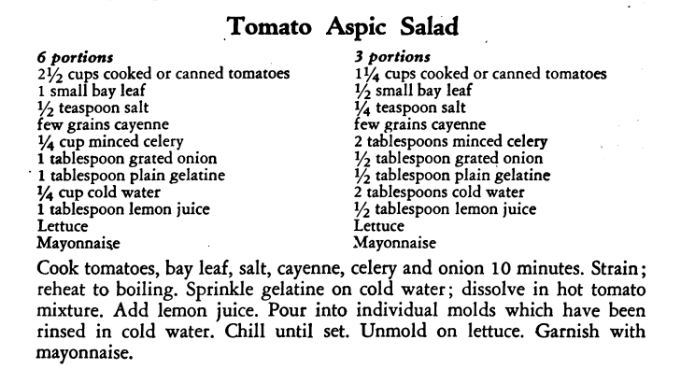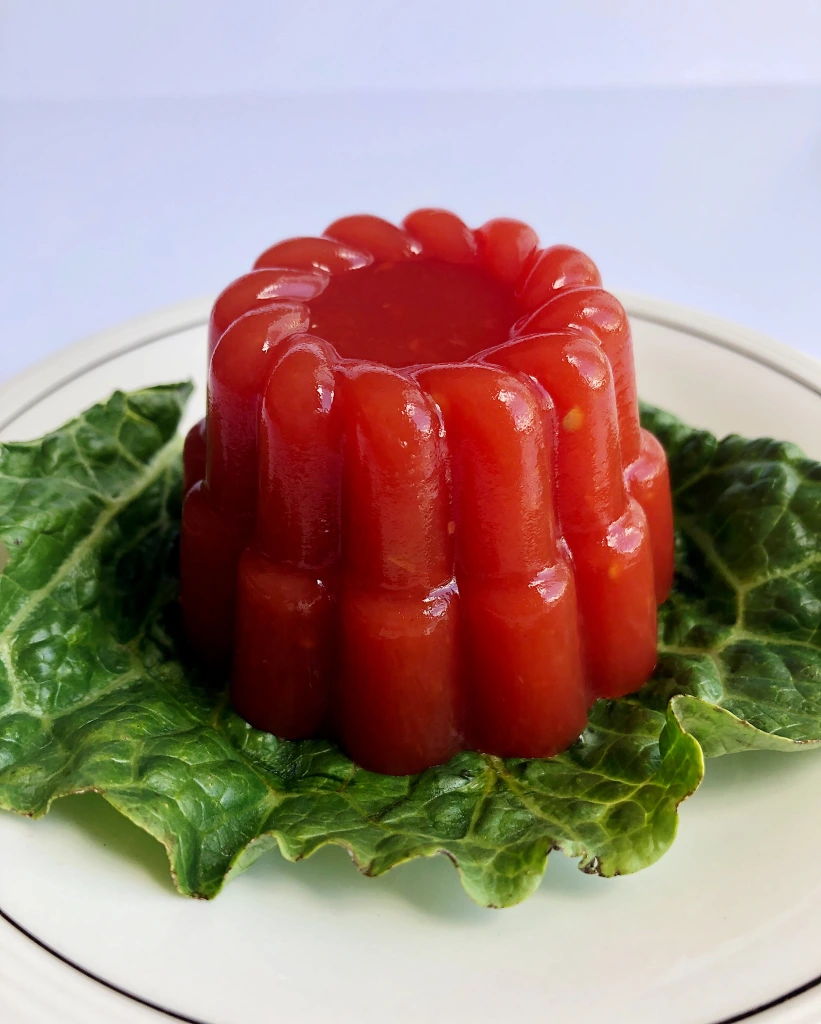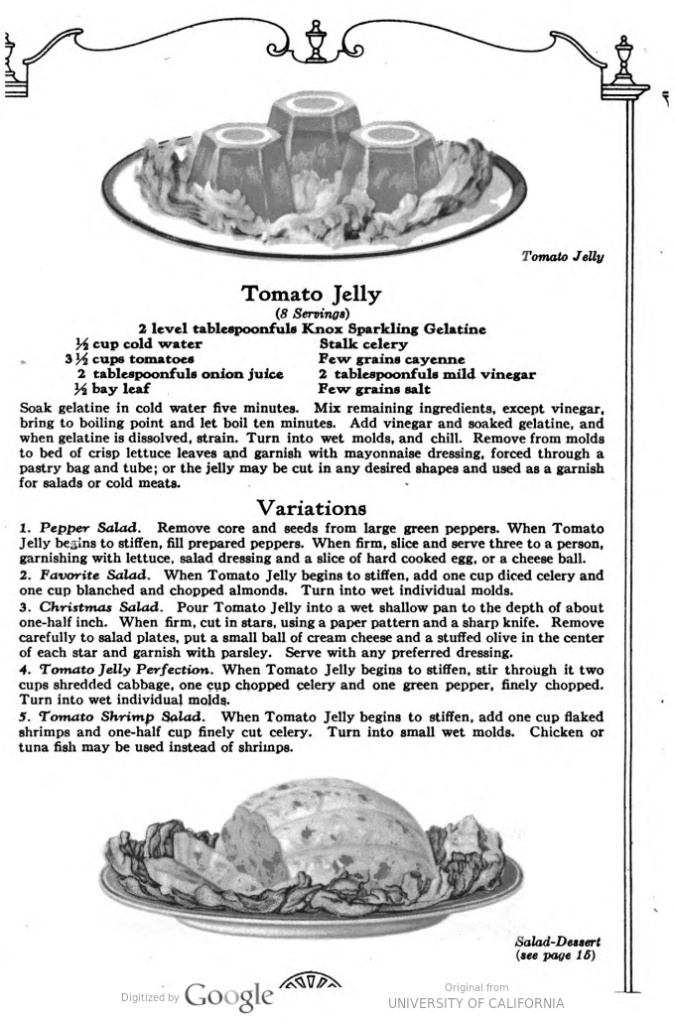Tomato aspic is one of those things I’ve wanted to try and also really not wanted to try, and I have approached both options with about the same level of enthusiasm.
I don’t really know what has been stopping me other than I guess I don’t know how to eat tomato aspic. Is it a garnish, a side “salad” or what? I suppose, subconsciously, I also know that everyone I live with will refuse to eat it so why bother.
I spend a good deal of time flipping through old cook books and nearly every book containing salads and gelatins between 1920-1940 has a tomato aspic in it. Midcentury aspic recipes of any kind are not that difficult to find.
The history of aspics (savory gelatin) actually goes way further back than that. Meat jellies were used in medieval and Renaissance cooking and were made by boiling pig’s feet and calf hooves. Dried fish bladders were the key ingredient of delicate fish-gelatin (isinglass) while seaweed-based gelatin was created in 17th-century Japan (kanten or agar-agar) and later used in northern Europe (irish moss). The cold and savory gelatin dish going by the name “aspic” started showing up at the end of the 18th century, particularly in France. But its popularity didn’t really take off in the United States until much later. And now the aspic, once a dish reserved for only the most refined palate, is forever engraved in our collective memory as a symbol of kitschy Americana.
The Recipe
This recipe comes from a 1943 food rationing cookbook called Victory cook book : how to eat well, live well, plan balanced meals under food rationing. I was inspired to flip through this book for a cooking challenge with Eaten Magazine.

Nothing screams “appetizing” more than good old war-time food rationing, so of course this is the one I went with.


A very unique – and appreciated- feature of this book is the option to make 3 portions instead of 6. Nearly all of the molded jello salads I’ve made yield a pretty large amount of food. This is fine when the salads are good, but when they’re not, well…
Although you can probably read the text in the image, here are the ingredients:
- 1 1/4 c. cooked or canned tomatoes
- 1/2 small bay leaf
- 1/4 tsp salt
- A dash of cayenne
- 2 T. minced celery
- 1/2 T grated onion
- 1/2 T. plain gelatine
- 2 T. cold water
- 1/2 T. lemon juice
- Lettuce and mayonnaise to garnish
Cook tomatoes, bay leaf, salt, cayenne, celery and onion for up to 10 minutes. Sprinkle gelatin over the cold water and let all the grains soak in. Meanwhile, strain the tomatoes and bring back to a boil. Remove from the burner and add the gelatin. Let it dissolve and add lemon juice. Mold. Serve over lettuce and garnish with mayonnaise.
Note:
Don’t let the tomatoes cook too long or you’ll end up reducing too much liquid.
As an added bonus, here is another tomato aspic recipe from 1927, complete with a list of variations. It is near-identical with the exception of using vinegar instead of lemon juice.

The Verdict
We decided that this aspic, despite its pretty decent herb-y tomato flavor, is not to be eaten on its own. Dipping it in mayonnaise isn’t an improvement either. However, I ate it on some bread with mayo and smoked turkey and I kind of liked it! Tasted like a sandwich with an aromatic tomato on it.

The reviews were mixed but mostly negative. One person said it tasted a little like marinara sauce jello. Another said it’s a dish best left as a relic of the past.
If you’re going to put tomatoes and onions anywhere near gelatin, it better be a savory aspic and not that chef or tuna “salad” nonsense with sweetened lime Jell-O. Molded salads should be sweet or savory, not both! So at least this recipe had that going for it.
Overall, it’s edible when eaten like a tomato. I didn’t think it was all that terrible, to be honest, but I wouldn’t say it’s particularly “good” either. Some people genuinely love tomato aspic but I’m guessing it’s a bit of an acquired taste.
This is a recipe that is more than worth making, if only for the sake of experiencing an interesting piece of food history!


~Feel like I’ve met a kindred spirit in you! 🙂 Aspic? Yes, everything you said. I’ve wantedtointendedtoputitoffalittlelonger make tomato aspic. Undaunted by the, uh, measured reviews, I’ll give it a try sooner than later now. I’m just hoping my joy in nostalgia is enough to balance out any likely sense that I just wasted a bunch of tomatoes! 🙂 🙂
LikeLiked by 1 person
Lol!! It’s never a waste if you’re having fun! And just imagine the looks of horror on your dinner guests’ faces! Worth it.
LikeLiked by 1 person
I laughed out loud when I read your reply! I do expect I’ll try this one on my own. There’s only so much good faith I can ask of dinner guests 😉
I’ll choke down my concern over aluminum and do it right: in the old, grayed, individual jello moulds. Finally, a reason to use them besides melting and remolding crayon stubs! Ever an optimist, here’s hoping the aspic turns out better than those crayons!
LikeLiked by 1 person
I’ll be here cheering you on!! Here’s a tip for you in case you’re still nervous to eat directly out of an old aluminum mold: Fill some vintage mini molds then mold the rest of the jello in a small serving bowl or other modern plastic mold. Eat the “safe” ones and simply admire the beauty of the others. After unmolding and thoroughly washing old aluminum molds a few times you become a little desensitized and eventually it won’t bother you anymore! And when you realize you’ve been eating out of 80 year-old molds and you haven’t gotten sick or died, then you’re good to go!
LikeLiked by 1 person
What do you do with melted down crayon stubs??
LikeLike
My family always ate it as an appetizer or side dish on the holidays. They would make it into a ring and place crab and shrimp in the middle, then squeeze lemon juice over it before eating it. As a kid, I remember it smelling up the whole house something awful, and refused to try it. As an adult, I eventually did after taking a dare from my cousin. It tasted nothing like it smelled. It was absolutely delicious!
LikeLike